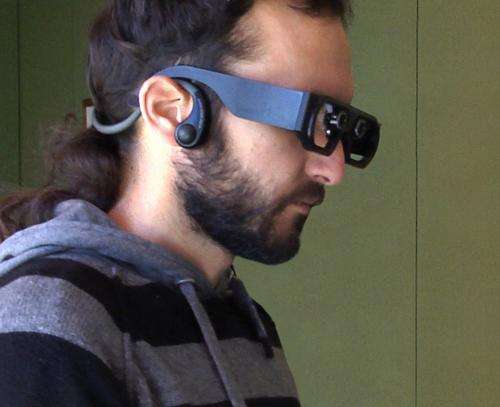A new, more economical sonification prototype to assist the blind

Researchers at Universidad Carlos III de Madrid (UC3M) have developed an assistive technology system that works by sounds which contributes to the autonomy of persons with visual impairments.
The commercial systems that exist today in Spain for the mobility of persons with sight impairment are insufficient, according to theseUC3M researchers, because they are costly and too bulky. The assistive technology, conceived as a sound guide that gives information as to the user's environment, aims to make an ingenious complement to the classic cane or guide dog more economical. This system's functioning is spelled out in the doctoral thesis of Pablo Revuelta Sanz, directed by the UC3M professors, Belén Ruíz Mezcua y José Manuel Sánchez Pena, who also belong to the Spanish National Centre for Subtitling and Audio-description (CESyA).
The proposal consists of a stereo vision processor that measures the difference of images captured by two cameras that are placed slightly apart and calculates the distance to each point in the scene. Then, it transmits the information to the user by means of a sound code that gives information regarding the position and distance to the different obstacles. "To represent height, the synthesizer emits up to eight different tones," its creators explained. In addition, the sounds are laterally located, so that something on the left sounds louder on that side, and vice versa.
The persons interviewed by the researchers in order to develop this project, complained, among other things, about the ungainliness of other systems. The new prototype is smaller, which makes it more practical. It is composed of glasses with two micro-cameras, a plate with a battery the size of a pack of cigarettes, a small audio stereo amplifier, and headphones with bone conduction transmission. The quantity of information received at the scene depends on the cognitive profile selected. "Six profiles, ranging from one that is very simple, with a sound alarm that only works when one is going to crash into an obstacle, to others that describe the scene with 64 simultaneous sounds," can be chosen, Pablo Revuelta pointed out.
In order to develop this project, interviews of experts in the areas of physical rehabilitation, visual impairments, and image and sight processing techniques and technologies were carried out. The transformation to sounds of the system was tested on 28 individuals, including sighted individuals, persons with limited vision and blind persons; and the final system was tested on eight blind persons in real environments. In general, it has real capabilities to describe the environment, although all the participants concluded that some refinements were necessary, including a reduction in the degree of error in the depth detector.
According to Pablo Revuelta, "the aim of the system is to complement a cane or a guide dog, and not in any way replace them." If the blind individual does not have hearing impairments, the system could be used. The system is not yet in its commercialization phase, because at the moment, only one prototype has been built. One of its main advantages is price, which they calculate to be around 250 euros, and that is "very economical compared with other systems that are currently on the market," according to the researchers. "It is our responsibility, and that of society as a whole, to guarantee the existence of this type of applied research if we wish to state without hesitation that we believe in the universal declaration of human rights and also put it into practice," Revuelta concluded.
Provided by Carlos III University of Madrid



















